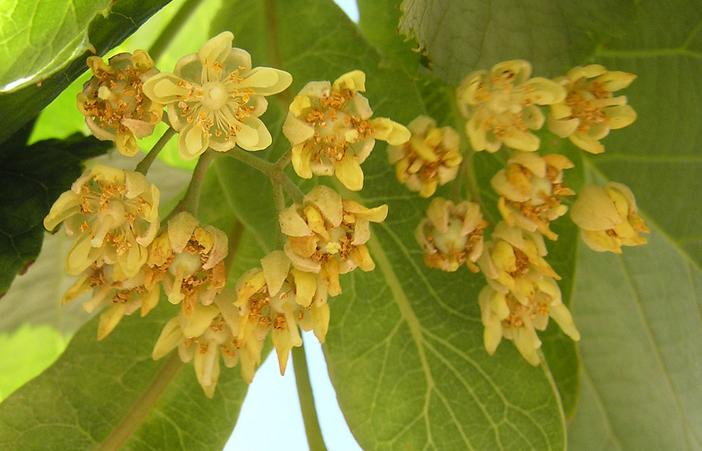European Lime
(Tilia ×europaea)
European Lime (Tilia ×europaea)
/
/

阿橋花譜 HQ Flower Guide
CC BY-SA 2.0
Image By:
阿橋花譜 HQ Flower Guide
Recorded By:
Copyright:
CC BY-SA 2.0
Copyright Notice:
Photo by: 阿橋花譜 HQ Flower Guide | License Type: CC BY-SA 2.0 | License URL: https://creativecommons.org/licenses/by-sa/2.0/ | Uploader: 阿橋 KHQ | Publisher: Flickr















































Estimated Native Range
Summary
Tilia ×europaea, commonly known as the European lime or common linden, is a hybrid between Tilia cordata (small-leaved lime) and Tilia platyphyllos (large-leaved lime), naturally occurring in a variety of habitats across Europe, including deciduous forests, forest edges, and riparian zones. This large deciduous tree can grow up to 164 feet (50 meters) tall with a trunk diameter of up to 8 feet (2.4 meters), often featuring a broad crown with dense foliage, burrs, and brushwood. The heart-shaped leaves are dark green, turning yellow in autumn. In early summer, it produces clusters of highly fragrant, creamy-yellow flowers that are attractive to bees and other pollinators.
The European lime is valued for its stately form, fragrant flowers, and the dense shade it provides. It is widely cultivated in urban areas, parks, and large gardens, often used for avenue planting due to its tolerance of pruning and pollution. The tree prefers moist, fertile soils with good drainage and thrives in full sun to partial shade. While it is generally low-maintenance, it can host heavy aphid populations, which result in sticky honeydew deposits beneath the tree. The leaves are edible raw, and the blossoms are traditionally used to make a soothing tea with mild relaxant properties. Some cultivars, such as ’Pallida,’ are popular for their uniform shape and vigorous growth. Potential problems include susceptibility to linden borer and leaf spot diseases. It is also important to be aware of the potential for large root systems that can disrupt pavements and structures.CC BY-SA 4.0
The European lime is valued for its stately form, fragrant flowers, and the dense shade it provides. It is widely cultivated in urban areas, parks, and large gardens, often used for avenue planting due to its tolerance of pruning and pollution. The tree prefers moist, fertile soils with good drainage and thrives in full sun to partial shade. While it is generally low-maintenance, it can host heavy aphid populations, which result in sticky honeydew deposits beneath the tree. The leaves are edible raw, and the blossoms are traditionally used to make a soothing tea with mild relaxant properties. Some cultivars, such as ’Pallida,’ are popular for their uniform shape and vigorous growth. Potential problems include susceptibility to linden borer and leaf spot diseases. It is also important to be aware of the potential for large root systems that can disrupt pavements and structures.CC BY-SA 4.0
Plant Description
- Plant Type: Tree
- Height: 50-130 feet
- Width: 50-70 feet
- Growth Rate: Rapid, Moderate
- Flower Color: N/A
- Flowering Season: Summer
- Leaf Retention: Deciduous
Growth Requirements
- Sun: Full Sun
- Water: Medium
- Drainage: Fast, Medium
Common Uses
Bee Garden, Fragrant, Low Maintenance, Street Planting
Natural Habitat
Deciduous forests, forest edges, and riparian zones across Europe
Other Names
Common Names: Large-Leaved Lime , European Linden
Scientific Names: Tilia ×europaea , Tilia cordata f. vulgaris , Tilia cordata subsp. vulgaris , Tilia cordata × platyphyllos , Tilia europaea var. hollandica , Tilia europaea var. hollandica , Tilia grandifolia f. praestabilis , Tilia grandifolia f. praestabilis , Tilia parvifolia subsp. vulgaris , Tilia parvifolia var. intermedia
GBIF Accepted Name: